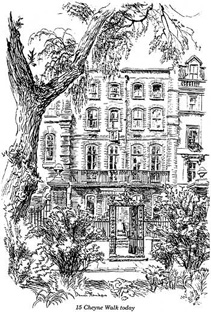Originally known as Carlton House, 15 Cheyne Walk, Chelsea was built in the early part of the 18th century by the architect Huddleston. It is an elegant four-storey house, the outside of which is substantially as originally constructed, although the wrought iron gate and railings have been repaired. Over the gate is a gilded dolphin taken from the crest of Lord Courtney, a one-time leaseholder. The wrought-iron work is said to be among the best three examples of the famous Chelsea ironwork. The lantern over the front door is probably an original, although now equipped with electric light.
15 Cheyne Walk is thought to be a replica of number 4, to which there is a striking resemblance, although 15 does not appear in any of the early plans of Chelsea to have incorporated the double ‘Powder room’ projection possessed by 4.13 and 14 Cheyne Walk have been demolished and rebuilt as flats, whilst 16 has had a face lift to the facade; so that 15 is unique in the preservation of the initial form. The interior also retains much of the original plan, although there has been some alteration – an interior partition for instance has been removed to give a larger entrance hall and sitting room. Much fine wood panelling has been preserved – a feature well shown on the main staircase. At the rear a large conservatory has been added recently. .As the Embankment dates from the 19th century, these dwellings would have been waterfront houses to the River Thames at the time of their construction and thus approachable by boat.
The first to live at 15 Cheyne Walk was Admiral Sir John Balchin (then a Captain) , who took up residence in 1717; the house was to remain his home until his death at sea in 1744, apart from two periods in 1724 and 1725 – 1728, when it was sub-let to Captain Reginald RN and to Captain Leonard Wynn RN respectively. The size of the house is perhaps an indication of the status of an 18th century naval Captain on the way to becoming an Admiral.
On the death of Admiral Sir John Balchin in 1744 Commodore (afterwards Vice-Admiral) Temple-West took up residency. He had married Frances Balchin, daughter of Sir John, so that the house still remained in the family. The Temple-Wests stayed in 15 Cheyne Walk until 1755, two years before the death of Vice-Admiral Temple-West in 1757.
Although the Balchin link with 15 Cheyne Walk ceases after 1755 the house has continued to accommodate a variety of distinguished tenants. From 1757 to 1760 it was the home of the Russian ambassador, whilst in the 19th century there was a succession of engravers, artists, musicians and painters as tenants. There was a long let between 1811 and 1867 when the famous engraver Henry Thomas Ryall was in residence. Thereafter the house passed to the Lawson family, who were well-known 19th century painters. William Lawson had three sons, Malcolm, F W and Cecil G, all gifted painters. The landscape painter Cecil G Lawson is probably the most notable, and a number of his works are still hanging in 15 Cheyne Walk at the present time.
The Balchin link was dramatically demonstrated a few years ago when repair work involved the removal of panelling and skirting boards in the kitchen and revealed a cache of invoices and bills from 1719!.
We are indebted to Mrs Allason for much of the above information, and for a reference to the Chelsea volume of the Survey of London which includes a description of the architectural features of the house

